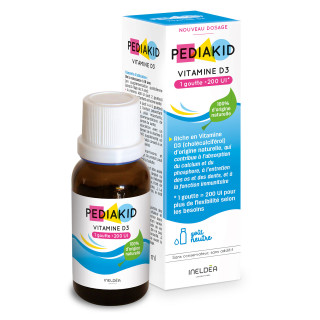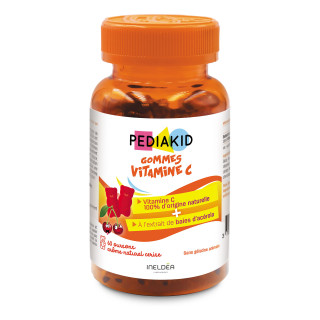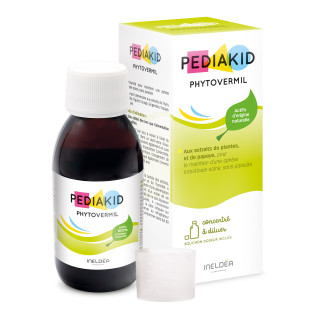- Promo

New - 200 ui per drop rich in naturally sourced vitamin d3, for a better absorption of calcium and phosphorus
Giving vitamin D supplements to a child is highly recommended for both growth and immunity. Vitamin D is an essential nutrient for the maintenance of bone and teeth, in both children and adults, as it enhances calcium absorption in the body. A vitamin D deficiency leads to disorders, such as rickets in children and osteomalacia in adults; it can cause osteoporosis if it is not controlled in the long term. In addition, vitamin D plays a major role in the good functioning of our cells and ensures better immunity.
Where do children use up vitamin D ?
Other than vitamin D supplements, good habits should be followed so that the body can make its own vitamin D and use it in its natural state wherever it is found.
The different forms of vitamin D
Vitamin D is stored in the liver, muscles and fatty tissues. It is divided into five forms numbered 1 to 5. The ones of most interest to us are vitamin D3, known as cholecalciferol, and vitamin D2, known as ergocalciferol.
Natural vitamin D3 is produced from the rays of the sun by our skin. Vitamin D2 is supplied by food. The difference between them is their origin but they are then processed in the same way by the body.
The special characteristic of cholecalciferol is that it stimulates immunity. In addition to encouraging growth, natural vitamin D3 strengthens the body and makes it possible to avoid many diseases, particularly asthma, flu and pneumonia. Studies were conducted in primary schools where the environment is favourable to the spread of winter diseases. The results were conclusive in children given vitamin D supplements as they had much better resistance to all epidemics.
Exposure to the sun
The main source of natural vitamin D is from exposure to the sun. Contact with UV rays allows the body to produce the vitamin D it needs. Nevertheless, it is important to be cautious because a few minutes a day is enough for a baby and overexposure to the sun is damaging, especially as infant skin is very fragile.
Depending on lifestyle and place of residence, your baby will have more or less exposure to the sun. Long winters, life in a flat and/or in the northernmost regions are more likely to lead to deficiencies. Babies living in the south or in the country where they are outdoors more have a lower risk of deficiency.
This is why the sun does not always (and in fact very rarely) meet your children’s vitamin D requirements and why it is essential to turn to food supplements, especially in winter.
Food
Food is another source of vitamin D which is found in oily fish (mackerel, tuna, trout, herring, salmon, etc.) and to a lesser degree in boiled eggs, mushrooms, butter and milk.
Cod liver oil is one of the richest sources of vitamin D but it is best to buy it in capsule form as it has such a strong taste in the liquid state that very few people can bear it.
It should be noted that breastmilk alone does not provide sufficient amounts of vitamin D.
Risks of deficiency
The risks of deficiency appear in children who are not sufficiently exposed to the sun. This risk increases in babies with highly pigmented skin as UV sunrays penetrate the skin less well. Bone growth accelerates and the need for vitamin D increases.
Vitamin D supplementation can therefore last until the end of the child’s growth, with a dose adjustment according to age.
What vitamin D dose is recommended for babies and children ?
Vitamin D doses are calculated in micrograms (µg) or in International Units (IU). The figures below are based on the national average. It is up to parents to adjust them according to place of residence and lifestyle. You can either give supplements continuously or only during winter if you feel your child has sufficient exposure to the sun the rest of the year. In all cases, it is advisable to speak to your paediatrician or attending physician.
Some children have a greater need for supplementation throughout the year. These include:
- children with very dark skin
- children who are less exposed to the sun, either because of their lifestyle or because of dermatological problems which stop them going outdoors
- obese children
- children on restrictive diets, such as vegetarian or vegan diets
- children on medication for the treatment of chronic diseases. This is often the case for diseases linked to digestive problems, nephrotic syndrome or kidney failure. It is essential to discuss this with your attending physician.
Vitamin D supplements in babies up to the age of 18 months
- If you breastfeed your infant or if your baby is fed cow’s milk: 25 to 30 µg a day, that is 1 000 to 1 200 IU, throughout the breastfeeding period.
- If your baby is fed on cow’s milk enriched with vitamin D : 15 to 20 µg, that is 600 to 800 IU.
In children aged between 18 months and 5 years
Two winter doses, one in February and the other in November, with each dose being between 2 000 and 2 500 µg, that is between 80 000 and 100 000 IU.
In growing adolescents aged between 10 and 18 years
The dose is the same as in children between 18 months and 5 years but can be administered in a single dose, in November, of 5 000 µg, that is 200 000 IU.
The ideal dose between 18 months and 18 years is to continue daily vitamin D supplementation of 100% natural origin which is much better assimilated than synthetic vitamins administered once or twice a year.
Rich in Vitamin D3 of natural origin, PEDIAKID® Vitamin D3 – 1000 IU has been formulated to ensure good assimilation and therefore contributes to maintaining bone and teeth health as well as supporting the body’s natural defences.
Is there a risk of vitamin overdose ?
There is a risk of vitamin D overdose but it is minute given how much the dose would have to be increased. To reach a critical threshold, the highest prescribed dose in adolescents of 200 000 IU would have to be taken for a whole year, every five days! For younger children who take daily doses, this would have to be multiplied by more than 10 for several days for it to reach a critical dose.
In such a case, hypercalcaemia would develop as excessive amounts of calcium would be assimilated. In parallel, surplus calcium in the urine could cause kidney stones.
Exposure to the sun and vitamin D overdose : impossible !
It is absolutely impossible to suffer a vitamin D overdose due to overlong exposure to the sun. Skin self-regulates and is not able to synthesise more than the equivalent of a dose of 10 to 20 000 IU.
There would really have to be extreme exposure to the sun to deregulate this mechanism inherent to epidermal functioning, but in such a case, you would suffer other more serious damage such as burning and dehydration.




